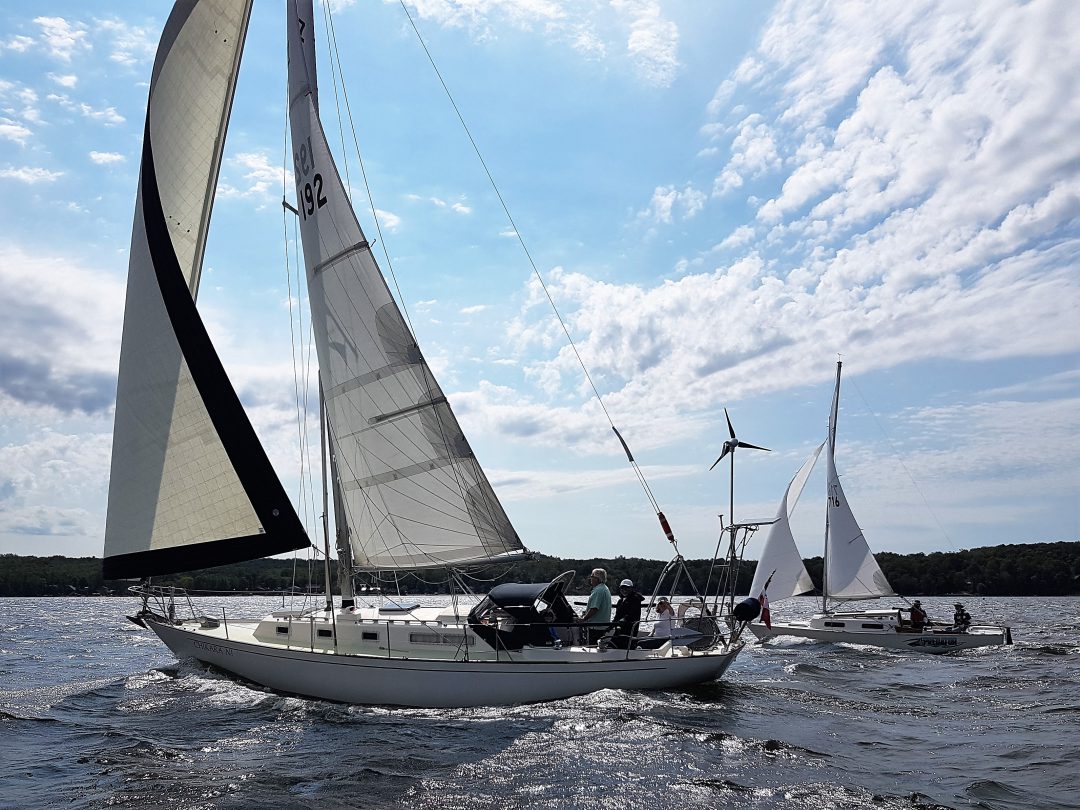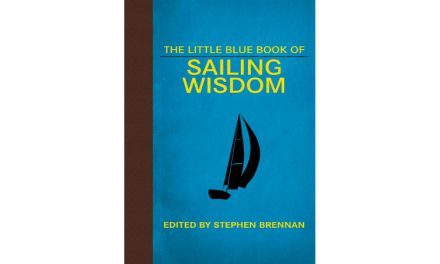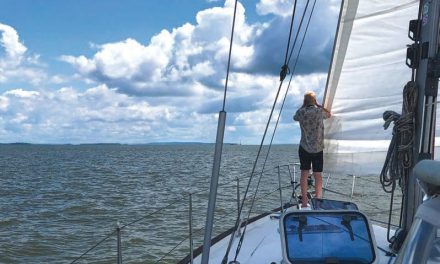
The author’s Alberg 37 looking good and sailing well after the race start.
This sailing tale needs to begin with the caveat that we are cruisers, not racers, and our 1978 Alberg 37 is outfitted as such. Yes, at one point in the Alberg’s past glory, she was considered fast by club racing standards and is still pretty quick in moderate to heavy air. But, when I say cruising, I mean there is little concern given for weight or what’s on the deck, which makes us heavy by racing standards.
We belong to the Midland Bay Sailing Club on the shores of Georgian Bay, Canada, home to some of the best cruising and gunkholing in the world. Once a year, our club sponsors a pig roast and pot luck dinner for our local YMCA camp. This is a club weekend with all members invited and it includes a race to the YMCA camp, hence the name Hog Race. Things were a little different as the YMCA camp was closed due to COVID-19 restrictions, but we made a day out of it anyway with a blessing of the fleet, sail past, and a modified Hog Race. All were welcome, cruisers and racers alike.
The weatherman was predicting some good winds in the afternoon gusting to 25 knots—Alberg weather! Needless to say, we were excited about the prospects of heeling over and sailing hard to windward. The rules called for your crew to be a part of your personal circle of close friends, so of course we invited two of our cruising buddies to crew with us. I kept thinking: “This might be our big chance to win the Hog Trophy!” Ah, the glory, I could see it now, holding the trophy above my head, just like the Stanley Cup.
To begin with, my crew and I were not familiar with the starting countdown—one horn blast to the 5-minute start then one blast starts the 5-minute countdown, then a couple more blasts to start the race. Well, we got all confused from the first blast and decided to just shadow the racers in the group, which actually worked. We weren’t the first to cross the starting line, but we were close behind. The first leg of the race was a downwind run and it was a more casual white sail race, so lucky us, no spinnakers allowed. We actually fared well following a very lightweight trimaran that blew across the line in a blur.
Sailing wing and wing, we were second overall and approached the first mark in good position. The wind was up to about 15 knots, which was great for our heavy displacement hull. As we rounded the first mark, the trimaran seemed to skip on top of the water, literally blasting off to the next mark at the top of Snake Island.
At this point, we were still in second, but first in the monohull class, which to me makes a huge difference. Now I say this because every sailor knows that a multihull can be very fast if the crew knows how to sail, or fly, as we witnessed and watched as she dashed all my hopes of taking line honors. We sheeted in and started beating towards the second mark behind the trimaran and ahead of the rest of the pack. As the wind picked up, it matched the adrenalin we felt as we heeled over and put the rail in the water. All was good! We rounded the second mark and set our sails for a dash to the finish line with the wind forward of the beam. If the winds held true, we would only have to throw in one tack to cross the line.
This is where things went awry; we needed to adjust our headsail and started to sheet in. Did I mention that we were cruisers? Because the wind was still brisk, one of the crew put too many wraps on our primary self-tailing winch and promptly locked it up. With a little further to go until we had to tack, we decided to wait until we tacked to unravel the fouled winch. Big mistake!
The wrap just kept getting tighter and tighter. When it came time to tack, the jib sheet wouldn’t budge, so we took the sheet from the port winch and brought it around to the starboard secondary winch in an attempt to ease the strain on the first jib sheet. Our secondary winch is not self-tailing and, well, didn’t we proceed to put too many wraps on it too and, you guessed it, locked that sheet up as well!
Now what do we do? By this time, we were getting close to the old town coal dock where the locals go with their families to picnic and fish on sunny afternoons. On that particular day, there was quite a crowd. There we were, heading straight for the dock at 6 knots with a full main and jib powering us forward. Fortunately for us, the coal dock has deep water that allowed us to come in close enough to surprise and delight the fishermen.
Tacking and throwing the boat into irons was our only option at the time… so we thought. We started the engine and turned head to wind to drop the main and figure out what to do about the jib sheets. All my hopes for the Hog Trophy were dashed in a panic-stricken moment. With the engine running and the mainsail down, we headed to windward and pulled the jib down too. Defeated, we motored back to the club for cocktails, BBQ, and of course to assess the situation we’d found ourselves in. As we sat in our cockpit lamenting our disastrous performance, some racers came over and wanted to know what happened, offer their condolences, and of course advise us about what they would have done under those not so uncommon circumstances.
Being cruisers, we never really had to sheet in as fast as we could—quick maybe, but surely not as fast as we could. What to do about a fouled winch was not something I had given much thought to, but in the racing community it is fairly commonplace. One friend said he carries a dedicated line with a pelican hook to hank on and run back instead of bringing the other jib sheet across. But the best suggestion for handling that horrible situation is to bring the other sheet over and secure it, then go forward and cut the jib sheet at the clew, let the other jib sheet take up the tension, and simply retie the jib sheet. Simple? Maybe, but going forward on a heaving deck with a knife to release the strain may not be the easiest task. Still, if there is a next time, I just might give it a go.

Alas, The Whole Hog trophy proved to be elusive for David and crew.





